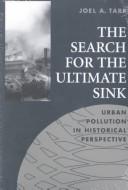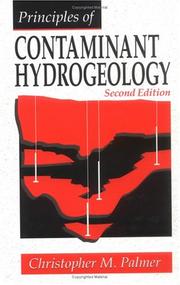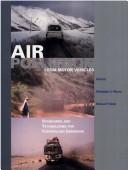| Listing 1 - 10 of 406 | << page >> |
Sort by
|

ISBN: 1282976621 9786612976629 1935603388 9781935603382 9781935603399 1935603396 9781282976627 6612976624 1884836054 9781884836053 1884836062 9781884836060 Year: 1996 Publisher: Akron, Ohio : University of Akron Press,
Abstract | Keywords | Export | Availability | Bookmark
 Loading...
Loading...Choose an application
- Reference Manager
- EndNote
- RefWorks (Direct export to RefWorks)
Urban pollution --- Pollution --- History.
Book
Abstract | Keywords | Export | Availability | Bookmark
 Loading...
Loading...Choose an application
- Reference Manager
- EndNote
- RefWorks (Direct export to RefWorks)
An analysis of provincial water pollution control shows that China's pollution levy system has been working much better than is commonly believed. Wang and Wheeler analyze China's experience with the water pollution levy, an emissions charge system that covers hundreds of thousands of factories. The levy experience has not been studied systematically, but anecdotal critiques have suggested that the system is arbitrarily administered and ineffective in controlling pollution. Critics view the levy as a local financing mechanism, but ineffective as a regulatory instrument. Enforcement is thought to vary widely, so that factories in different regions face different penalties for polluting. And it is widely believed that the levy provides little incentive to control pollution because official rates are below marginal abatement costs. Wang and Wheeler test the conventional critique of the levy system using solid new province level data for 1987-93. Their results suggest that the water pollution levy system is neither arbitrary nor ineffective. Across provinces and over time, variations in the effective levy rate are well explained by proxies for local valuation of environmental damage and community capacity to enforce local norms. During 1987-93, rapid development in many provinces led to sharp increases in the effective rate. Their results also suggest that the emissions intensity of Chinese industy was highly responsive to those increases, because marginal abatement costs were often lower than levy rates. And from 1987 to 1993, provincial pollution intensities fell at a median rate of 50 percent, and total discharges at a median rate of 22 percent. The results suggest several lessons for regulators in developing countries: * Local enforcement of national standards will determine the effective price of pollution in each area. Such regional heterogeneity is natural and legitimate. * The locally enforced price of pollution rises with industrial development. * Early in the regulatory process, industrial emissions intensity is highly responsive to changes in the price of pollution, mainly because marginal costs are often quite low in low to medium abatement ranges. In China, provincial adjustments of effective levy rates and other regulatory instruments have been sufficient to induce sharp declines in emissions intensity and reductions in total emissions from registered factories during a period of rapid industrial growth. This paper -- a product of the Environment, Infrastructure, and Agriculture Division, Policy Research Department -- is part of a larger effort in the department to identify appropriate policies for environmental regulation in developing countries. The study was funded by the Bank's Research Support Budget under research project The Economics of Industrial Pollution Control in Developing Countries (RPO 680-20).
Water --- Pollution. --- Pollution
Book
Year: 1996 Publisher: Genève : OMS [Organisation Mondiale de la Santé] = WHO [World Health Organization],
Abstract | Keywords | Export | Availability | Bookmark
 Loading...
Loading...Choose an application
- Reference Manager
- EndNote
- RefWorks (Direct export to RefWorks)
Ecology. --- Pollution. --- Water pollution
Book
ISBN: 2080354531 9782080354532 Year: 1996 Volume: 97 Publisher: Paris: Flammarion,
Abstract | Keywords | Export | Availability | Bookmark
 Loading...
Loading...Choose an application
- Reference Manager
- EndNote
- RefWorks (Direct export to RefWorks)
Book
Year: 1996 Publisher: Lausanne : Ecole polytechnique fédérale de Lausanne [E.P.F.L.],
Abstract | Keywords | Export | Availability | Bookmark
 Loading...
Loading...Choose an application
- Reference Manager
- EndNote
- RefWorks (Direct export to RefWorks)
Book
Year: 1996 Publisher: Geneva : United nations conference on trade and development,
Abstract | Keywords | Export | Availability | Bookmark
 Loading...
Loading...Choose an application
- Reference Manager
- EndNote
- RefWorks (Direct export to RefWorks)
Environnement --- Pollution des sols --- Pollution
Dissertation
Year: 1996
Abstract | Keywords | Export | Availability | Bookmark
 Loading...
Loading...Choose an application
- Reference Manager
- EndNote
- RefWorks (Direct export to RefWorks)
Soil pollution --- Hydrocarbons --- Pollution --- surveys
Book
Year: 1996 Publisher: [Washington, D.C.] : U.S. Environmental Protection Agency, [Office of Water],
Abstract | Keywords | Export | Availability | Bookmark
 Loading...
Loading...Choose an application
- Reference Manager
- EndNote
- RefWorks (Direct export to RefWorks)
Nonpoint source pollution --- Agricultural pollution --- Prevention.

ISBN: 1566701694 Year: 1996 Publisher: Boca Raton (Fla.) : CRC press,
Abstract | Keywords | Export | Availability | Bookmark
 Loading...
Loading...Choose an application
- Reference Manager
- EndNote
- RefWorks (Direct export to RefWorks)
Groundwater --- Hydrogeology. --- Pollution.

ISBN: 0821334441 Year: 1996 Publisher: Washington, D.C. World Bank
Abstract | Keywords | Export | Availability | Bookmark
 Loading...
Loading...Choose an application
- Reference Manager
- EndNote
- RefWorks (Direct export to RefWorks)
| Listing 1 - 10 of 406 | << page >> |
Sort by
|

 Search
Search Feedback
Feedback About UniCat
About UniCat  Help
Help News
News